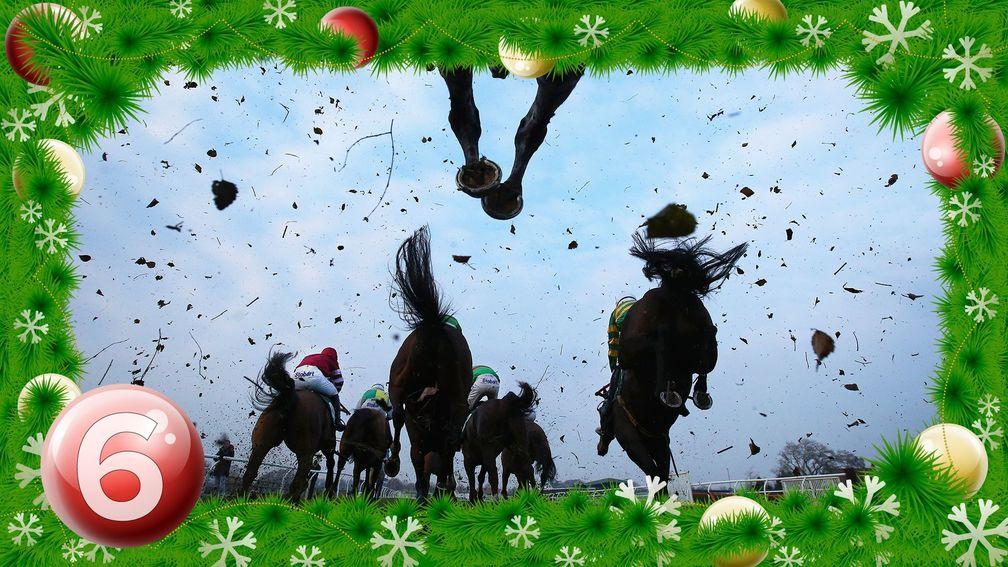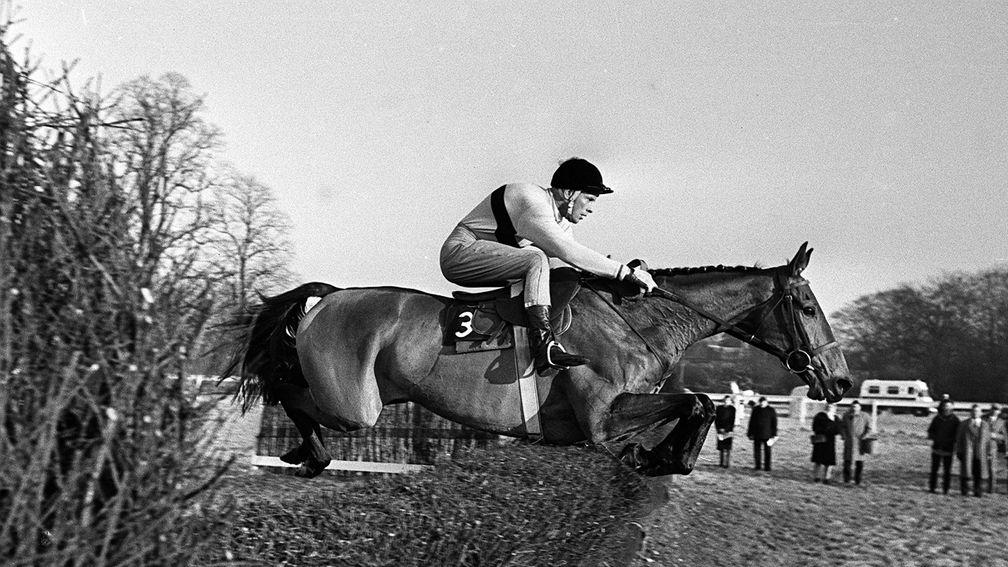All horses can jump – but when and how well is a more complex matter

On the sixth day of Christmas, Racing Post gave to me . . . a guest column by legendary trainer Henrietta Knight – first available to Members' Club subscribers on December 17, 2018. Click here for more information and to sign up
How many times does an owner, breeder or trainer say “Let’s see if he can jump”? But provided they are not hurting, all horses can jump – it is just a question of proficiency and whether they enjoy it. Techniques vary and jumping ability is undoubtedly linked to conformation, breeding and training. Confidence and temperament are key factors as well.
Some are complete naturals whereas others need plenty of education. Slow learners who begin with a blank sheet often prove to be the best jumpers in the long term because they have not acquired bad habits. Ignorance is bliss. The horses have no adverse memories to erase.
When it comes to jumping obstacles at three or four years old, Flat-bred horses often show greater athleticism than their National Hunt counterparts. They tend to be more mature and are neater types carrying less bodyweight. They are lighter on their feet and built like young gymnasts, which explains why many of the French-bred jumpers begin their racing lives at a young age.
A number of them have Flat-race pedigrees and, in particular, a fair amount of American blood. Indeed, in the past, many top showjumpers in the US were thoroughbreds. They were horses who came off the Flat – beautiful, elegant ballet dancers.
By and large, the Irish and British jumps-bred horses are later developers and heavier topped. The youngsters do not easily balance themselves on corners or on the approaches to an obstacle. These late-maturing types are often on their forehands because they are still growing and their hindquarters are higher than their withers (the top of the shoulder in front of the saddle). They resemble gangly overgrown schoolchildren.
Too much, too soon?
Many people expect too much at an early age from young National Hunt-bred horses, whose minds and bodies are often unready to take the pressures of racing. Is it right to run them in four-year-old steeplechases?
The same question applies to four-year-old point-to-point races which are in abundance in Ireland and from which many horses get sold for vast sums of money at the leading bloodstock sales. It cannot be right to apply undue pressure to immature bodies – the skeletal structure simply cannot take it.
In the point-to-point world it seems to me there is probably an unnecessarily high percentage in wastage of future chasers at a young age. Unfurnished three-year-olds are hurriedly prepared to show up well in the four-year-old point-to-point races but they may never make it to the track and many of those who do are never heard of again. The point-to-points are often run on unsuitable ground – too heavy or too firm – and the youngsters are ridden, in many cases, by inexperienced amateurs.
Admittedly there are a number of top riders who travel the point-to-point circuits like Jamie Codd and Derek O’Connor who are household names, and certain top horses have started their careers between the flags as four-year-olds, in particular Best Mate, Florida Pearl, Faugheen and Samcro. But these stars would probably have shone through anywhere and due to their inborn natural ability would have risen to the top from day one. They presumably took their training with ease and it is unlikely they were put under any pressure at home.
Education, education, education

In jump racing it is essential horses are well schooled, not only for their own wellbeing but also for the sake of the jockeys who ride them. Often races are won by a horse making ground through the air over an obstacle.
This depends upon accuracy on the take-off side of a fence and is closely linked to confidence. Nowadays trainers take a lot of trouble getting their horses to jump well at home. Many of these top professionals have access to superb facilities and use good, experienced jockeys to teach their recruits. There are no short cuts.
All horses deserve an equal chance but those teaching them must know exactly what they are doing too and be well educated themselves on the jumping front.
Some trainers know a lot more than others. Tom Dreaper, who trained Arkle, schooled his horses meticulously in the 1960s and 70s. He allowed his horses plenty of time to mature and seldom even ran them in bumpers until they were five or six years old. Jumping was so engrained in them that a jockey once said that if the horse he rode had been asked to jump the fences backwards on the way to the start he would have obliged.

Many horses are taught to jump in loose schools where they negotiate obstacles without the hindrance of a jockey on their backs. This is a great educational aid and the horses can learn to make mistakes and correct themselves. They adjust their strides and perfect their footwork.
It is well known the best jumpers move their feet quickly in front of a fence – they pat the ground – whereas poor jumpers are slow with their footwork and often appear stuck to the ground on the take-off side of an obstacle. Their reactions are far from sharp.
Trainers must be vigilant
However well horses are schooled at home they do not always reproduce what they have learned when they run in a race. Maybe they are experiencing pain or maybe their temperaments are not suited to racing.
Nowadays kissing spines have been diagnosed by many of the leading veterinary surgeons and, since a horse’s back needs to be in tip-top shape for jumping, this condition could well handicap many chasers.
A horse needs to be supple in its back and round it over an obstacle but if the bony processes of the vertebrae are rubbing together the horses must be suffering a lot of discomfort. No wonder some of them jump with hollow or straight backs as well as holding their heads high. They are trying to compensate for the pain.
If a horse is jumping with a straight back and its head in the air, maybe the trainer should be investigating the possibility of kissing spines.
However, this is not the only disorder that can cause bad jumping. There are other physical problems which need to be considered too – horses will hang if they are in pain and this may not come from their backs.
Too many horses are condemned as ungenuine. How would those who label them as such like to lump loads of weight round jump tracks if they were experiencing pain? Very few horses are born ungenuine. It is the way they are trained and ridden that causes them to find ways to escape. Don’t condemn the horses, they try to please us but may find it hard to execute all the tasks that are put before them.
The punters of this world should stop and ask “Is this horse hurting?” I would always give the horse the benefit of the doubt. Sometimes we ask them to do the impossible.
On the whole horses enjoy jumping and are competitive by instinct. Provided they are trained correctly, they will demonstrate their ability when they get to the racecourse.
Henrietta Knight’s new book The Jumping Game is out now. Order your copy for £20 from racingpost.com/shop
Members can read the latest exclusive interviews, news analysis and comment available from 6pm daily on racingpost.com
Published on inSeries
Last updated
- We believed Dancing Brave could fly - and then he took off to prove it
- 'Don't wind up bookmakers - you might feel clever but your accounts won't last'
- 'There wouldn't be a day I don't think about those boys and their families'
- 'You want a bit of noise, a bit of life - and you have to be fair to punters'
- 'I take flak and it frustrates me - but I'm not going to wreck another horse'
- We believed Dancing Brave could fly - and then he took off to prove it
- 'Don't wind up bookmakers - you might feel clever but your accounts won't last'
- 'There wouldn't be a day I don't think about those boys and their families'
- 'You want a bit of noise, a bit of life - and you have to be fair to punters'
- 'I take flak and it frustrates me - but I'm not going to wreck another horse'